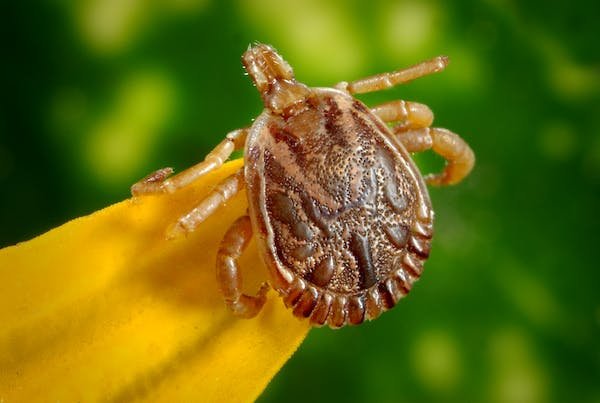The Implication of Tick Attack on Animals.
After a long time of dropping my pen on the hive community and making the choice to spend time in the study of animals (veterinary medicine), I have picked back my pen to share knowledge on different animal lifestyle, the disease affecting them and how they can live in a better environment protecting their lives, after all, not only humans deserve a good life, even animals do.
As regards my first post in this community, I will be writing about ticks. Ticks are popular in attacks on domestic livestock, they are considered the most important ecto-parasites in livestock, they create great loss economically to livestock. There are two popular categories of ticks found in the United States, we have Ixodidae referred to as hard ticks and Argasidae also known as soft ticks, the popularity of ticks to bite and transmit disease to humans is really rare. There are 700 existing species of hard ticks, there are also 200 existing species of soft ticks, but not a large percentage of these existing ticks can transmit disease to humans.

pexels.com
Hard Ticks: Hard ticks are scientifically called Ixodidae, it is laid by an adult female thick and that happens to be its origin, when there is a hatch of the egg, it creates the emergence of a larva, this larva must search for a host which could either be a mammal or a bird to feed on. After feeding on it successfully, it drops from the host body to the ground, then proceeds through a molten stage, and eventually comes out as a nymph.
This created nymph seeks a larger host to survive, the entire life cycle of a hard tick is about 1-2 years depending on the specie of the hard tick. They also take time to feed on their host, their bite is usually a painless one, with the process of feeding going for as long as days in some occasions and sometimes, it could even last for weeks.
Soft Ticks: Soft ticks are scientifically called; Argasidae, they also begin in the form of an egg like in the case of hard ticks, then proceed to hatch into a larva, they also feed on a host and molt into a nymph. Nymphal soft ticks go through several stages, even as much as seven stages in some occasions, every stage however requires blood meals. Depending on the specie of the soft tick, the life cycle could last for months and years in some cases. The bite as well is a painless one on its victim, it could take around 15-30 minutes for a successful bite, making it even more difficult to detect its presence.
While we have two major categories of tick, tick comes in different forms and types;
American Dog Tick: Dermancetor Variabilis They have a dark-brown physical appearance, the females have a shield that is off-white while the adult males appear mottled. The adult females of the American dog tick, causes rocky mountain spotted fever, when they attack their host. Other names for rocky mountain spotted fever are; tick paralysis, Ehrlichia or Turalemia. It is easier to find American dog ticks in areas where there is little or no tree cover, or trails and walkways.
Brown Dog Tick: Rhipicephalus Sanguineus This tick type comes in a reddish brown form and a narrow shape when compared to other forms of ticks. The different stages of brown dog tick can transmit Rickettsia rickettsia (Rocky Mountain spotted fever), they are also responsible for the spread of several other diseases to dogs.
Dogs are actually the main/primary host for brown dog tick found around the globe, the brown dog tick can breed and survive in nature, they are primarily found in homes around with dogs, these ticks can spend their entire life cycle indoors. In order to treat brown dog tick infestations, it is usually recommended that all house pets and the environment are sanitized from time to time.
Blacklegged Deer Tick: Ixodes Scapularis This tick has a physical reddish-orange body, it has black shields as well as dark black legs. It is popular for the transmission of these diseases and viruses;
- Borrelia burgdorferi which is the agent bearing Lyme disease.
- Borrelia mayonii which is an agent causing a lyme-like disease.
- Borrelia miyamotoi and Borrelia hermsii, both cause relapsing fever Borreliosis.
- Babesia microti cause multiple species of Rickettsia, deer tick virus and Powassan virus, there are also suspicion of these thick types transmitting Bartonella to humans.
Black legged ticks are found in several habitats, these habitats that are suitable for birds, small and large mammals like the deer, squirrel, coyotes, mice and livestock. Every stage of black legged ticks can attack and bite even humans, but nymphs and adult females are common amongst the people in contact to grass, leaves, brush, pets and logs.
Rocky Mountain Wood Tick: Dermacentor Andersoni, These ticks come in a reddish-brown form, and they are closely related to American dog ticks, the adult males of this tick types have a cream-colored shield. Saliva coming out from the rocky mountain wood tick contains neurotoxin, these neurotoxins can cause tick paralysis from time to time in both pets and humans, once the ticks are removed, it takes around 24-72 hours to take away the toxins of the tick.
Groundhog Tick: Ixodes Cookei, this tick type have a light brown or blond color, they are also known as woodchuck tick, as they are the primary vector for Powassan virus disease.
The tick type is commonly found through the eastern half of the United States, every stage of the tick feeds on different warm-blooded animals, including foxes, weasels, skunks, raccoons, groundhogs and on several occasional situations, they also attack domestic animals and humans too.
Western Blacklegged Tick: Ixodes Pacificus, this tick type comes in the form of a black shield and black legs. This tick types are responsible for the transmission of Lyme disease. This tick type is common amongst lizards, vole, fox, mice, coyote, deer and even squirrel.
Lone Star Tick: Amblyomma Amercanum, this tick is a reddish-brown colored one, the adult form of this tick is differentiated with a white dot or a lone star at her back. This tick type is greatly distributed through the Eastern part of the United States, but it is more prevalent in the Southern part.
Pacific Coast Tick: Dermacentor Occidentalis Every stage of this tick type is dangerous, as it has the ability to transmit the Rocky Mountain spotted fever to pets and even to their owners, they can also transmit Colorado tick fever virus, just a bite from this tick would create a wound that is usually mistaken for other forms of insect and spider bites.
Once ticks are realized in the bodies of a domestic animal, they have to be removed as soon as possible, the fast removal of the ticks would minimize the level of damage and disease. It is a wrong move to remove a tick with bare hands, as this may cause the spread of some tick borne diseases through available breaks in the skin or contact with the mucous membrane. The domestic animal should as well be treated with anti-tick insecticides and every other form of treatment as recommended by the veterinary doctor.

pexels
Dogs are the most common domesticated animals affected by tick, in order to answer the question on how ticks affects man's best friend as they are popularly being called, I will give a brief explanation on that. Ticks gets attached to dogs through the insertion of their mouth parts into the skin of the dogs. Some tick types, as seen in the description above, produce sticky, glue-like substances that helps them stay glued to the dog, this ticks begins to feed on the dog's blood, the places where the ticks are glued would turn red and irritated.
Even if this is a rare case, the chance of a tick consuming so much blood of the dog to the point where it creates an anemic condition is very possible.
I feel, at this point, I will have to drop the pen here. I am back now, to produce as many animals based scientific topics as possible, and I hope you find it interesting and worth your time.
References.
https://www.lymedisease.org/types-of-ticks/
https://livestockvetento.tamu.edu/insectspests/ticks/
https://www.ncbi.nlm.nih.gov/pmc/articles/PMC1635821/
https://www.msdvetmanual.com/dog-owners/skin-disorders-of-dogs/ticks-of-dogs
Thanks for your contribution to the STEMsocial community. Feel free to join us on discord to get to know the rest of us!
Please consider delegating to the @stemsocial account (85% of the curation rewards are returned).
You may also include @stemsocial as a beneficiary of the rewards of this post to get a stronger support.
Congratulations @futurekr! You have completed the following achievement on the Hive blockchain and have been rewarded with new badge(s):
Your next target is to reach 300 comments.
You can view your badges on your board and compare yourself to others in the Ranking
If you no longer want to receive notifications, reply to this comment with the word
STOPTo support your work, I also upvoted your post!
Support the HiveBuzz project. Vote for our proposal!
I remember removing ticks from my childhood dog. It's not easy as the heads tend to detach easily from the body and stay stuck on the skin if you don't do it correctly!
Most people have this experience. Removing ticks from the body of animals can be very difficult
I can relate. When I newly got my dog, it was a struggle.
I have successfully eradicated the tick from my household and dog.
An experience most people have provided you have a dog or cat, and when you have a cattle ranch